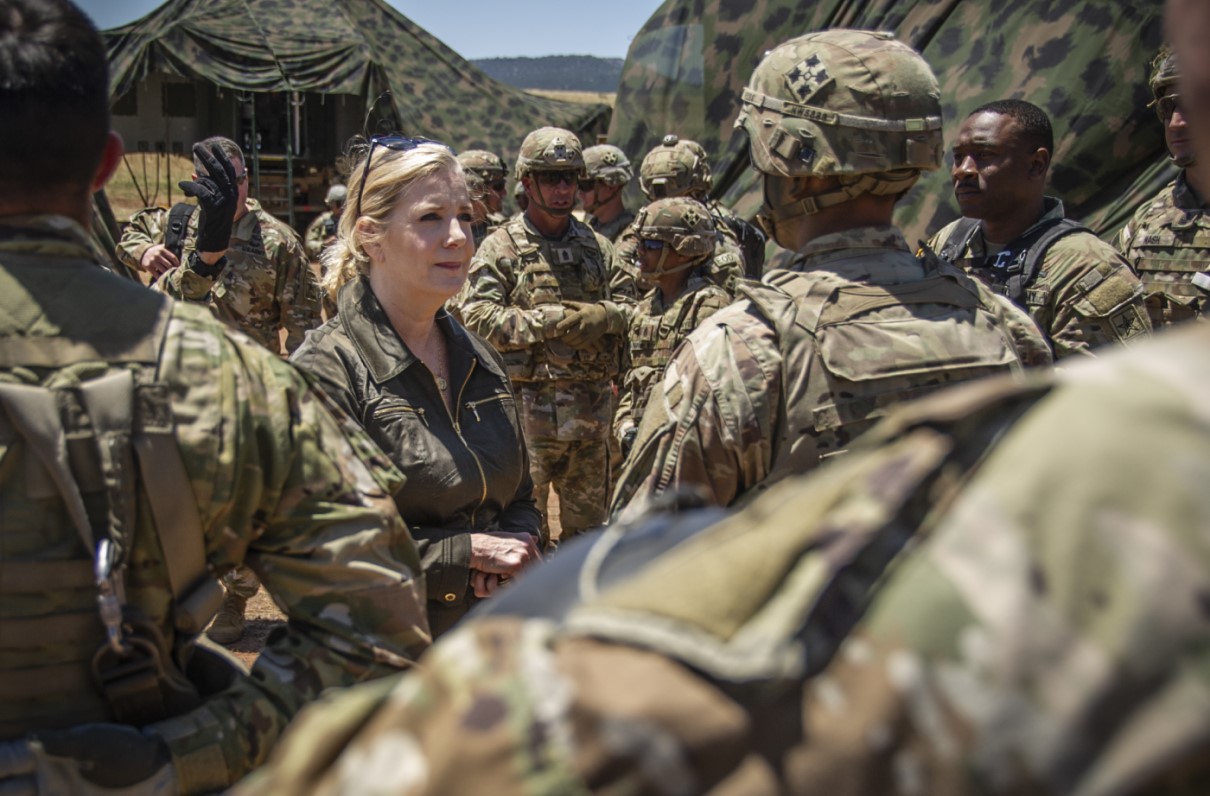(This article originally appeared in the November 2022 issue of Military Officer, a magazine available to all MOAA Premium and Life members. Learn more about the magazine here; learn more about joining MOAA here.)
Christine Wormuth’s journey to the Pentagon began to take shape at a young age. Growing up in the multicultural town of College Station, Texas, and seeing the Berlin Wall fall while living in Paris for her junior year of college piqued her interest in national security.
Scoring an internship with the Presidential Management Fellows Program, she knew she was in the right place to grow her career.
“I absolutely aspired to be working in this building [the Pentagon] at a young age, relatively speaking,” Wormuth said. “And I have been very lucky to be able to do so.”
Wormuth went on to serve in the Obama administration in several capacities, including the under secretary of Defense for Policy. After a stint as the director of the International Defense and Security Center at the RAND Corporation, she was nominated as Army secretary in 2021.
[MOAA INTERVIEW: Air Force Secretary Frank Kendall on Preparing for the Next 75 Years]
Military Officer sat down with Wormuth in July to discuss a variety of topics including the future of the Army, improving housing and morale among soldiers, and serving as a role model for women in the military. The following interview has been edited for length and clarity.
Q. The Army’s recruiting challenges have made a lot of headlines. What do you see as the service’s largest recruiting challenge? What are some ways you are tweaking incentives or tactics to improve recruiting?
A. The biggest challenge we have, frankly, is the fact that only 23% of Americans are, physically and from a conduct perspective, qualified to join the Army in the first place. ...
I think that something we can control in the Army ... is how do we do a better job of telling our story to more young Americans than just those who grew up in military families? … 83% of the people in the Army today come from military families.
[RELATED: Army Ended Fiscal Year Short Almost 20,000 Soldiers, Top General Says]
We’re running some new campaigns that talk about the kind of practical benefits that you can get in the Army. ... But we also, I think, have to look at how do we get more Army figures out into towns and communities all around the country talking to kids, not just in high schools. More and more kids are graduating from high school and going on to college than they did in the past. But there are a good number of kids who start college but don’t finish up for whatever reason. And I think that’s a population that we need to do a better job of finding and talking to them about what the Army can do for them.
Q. With the reduction in end strength for the Army, what steps are you taking to make sure that this doesn’t result in a “do more with less” environment?
A. There are two things I think we’re going to try to do to make sure we don’t have that kind of situation in the near term. … For example, let’s take the 82nd Airborne. We want to make sure that the 82nd Airborne is fully manned so that they’re able to respond on short notice when necessary. So we probably will look at [whether] we need to shift personnel to those high readiness units. If we have shortfalls in terms of personnel, that’s kind of a bridging strategy.
And then we have a process in the Army called total Army analysis. That is how we look at what new types of units we [are] growing. ... But we also use the total Army analysis process to help us figure out where do we need to make adjustments to units, whether it’s thinning out the force structure or whether it’s getting rid of entire units.
[TAKE ACTION: Protect the All-Volunteer Force and Personnel Strength in the NDAA]
Q. What does it mean to you to be the first woman to be named secretary of the Army?
A. I don’t think about that a lot. But what I think it means is for women who are already in the Army and young women who might be thinking about coming into the Army, I do think it sets an example for them that shows that women can lead at the most senior level. And I think, it gives them more confidence to think that they can succeed as a senior leader.
When I go and visit installations, it is not uncommon for young women, whether officers or NCOs or enlisted soldiers, to come up and talk to me about that. And so I think just as it was important when the Army had its first four-star female general, having a first female secretary of the Army sort of sends that signal.
Q. [What are some] examples of how the Army is improving the barracks and Army-owned housing?
A. We have a 10-year facilities investment plan where we are using that plan to help us make sure that we are tearing down and building new barracks or renovating existing barracks. And we are spending about $1.2 billion a year on barracks, whether that is military construction or whether it is renovation and modernization.
[RELATED: Army Senior Leaders Commit to Improving Quality of Life]
Q. What does the Army of 10 years from now look like, and how do we get there?
A. You are going to see us bring a whole series of new weapons into the force. You’re going to see robotic combat vehicles, you’re going to see new long-range precision fires systems like the extended range cannon artillery, the precision strike missile, long-range hypersonic weapons. And we’re actually going to start fielding the first pieces of those systems in fiscal year.
And I think you’ll also see those systems enabled by greater artificial intel ... And then we’re also going to really be investing in a network that allows us to share data much more easily, not only across the Army, but also with our sister services.
But there’s a human dimension to the Army of 2030 where we’re really needing to focus on making sure we’re developing leaders who can operate all of that high-tech equipment and who can operate in a very highly contested environment. So a lot of what we’re doing is investing in making sure that our NCOs and officers understand the threats they may face today.
Military Officer Magazine
Discover more interesting stories in MOAA's award-winning magazine.

